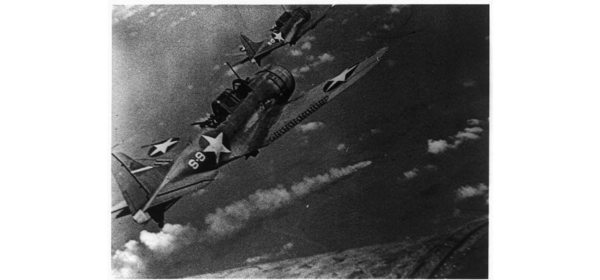
The Battle of Midway is one of history’s most critical naval battles. (Photo: U.S. Library of Congress)
The Battle of Midway occurred at a time when the prospects of U.S. victory in the Pacific theater of World War II were remarkably dim.
Launched by an overconfident Japanese military, the battle marked the end of Japanese offensive operations in the South Pacific, allowing the United States to mount a series of campaigns that would ultimately end with Japan’s unconditional surrender years later.
Prelude to the Battle of Midway: Dec. 7, 1941–May 8, 1942
For the United States, the initial months of World War II were brutal.
Imperial Japan continued its conquest of the South Pacific virtually unopposed, and a string of U.S. military defeats—starting with the surprise attack on Pearl Harbor and ending with the occupation of The Philippines—led Japanese leaders to assume that American withdrawal from the Pacific War was imminent.
However, this early Japanese success bred arrogance that created an opportunity for American military commanders.
The Battle of Midway: June 4–7, 1942
Despite losing two of six aircraft carriers at the Battle of the Coral Sea a month earlier, overall success to this point led Japan to continue with its plans to destroy what remained of U.S. Naval power in the Pacific.
Japan had two goals for the Battle of Midway: First, to extend its defense perimeter, ensuring the United States could not attack mainland Japan again. Second, to destroy America’s remaining carriers, which Japan believed would knock the United States out of the Pacific War.
The Seeds of Japanese Defeat: Broken Intelligence and Poor Planning
Unfortunately for Japan, U.S. intelligence had cracked the Japanese military code weeks before Midway and was fully aware of Japan’s entire plan of attack. Additionally, Japan falsely believed that U.S. morale had been depleted and that the United States had fewer carriers than it had.
Worse, Japan was completely blind to U.S. carrier movements in the days leading up to the battle. Though Japan still held a strong numerical advantage, Japanese commanders spread their attacking forces so thin that individual fleets could not support one another in the event of a U.S. counterattack.
The First Day
The initial Japanese air assault on the U.S. base at Midway was largely successful, but it gave U.S. forces time to locate the attacking Japanese carriers. A series of staggered U.S. airstrikes kept Japan on the defensive while a separate U.S. attack proved extraordinarily decisive. In about an hour, three of the four carriers that Japan sent to Midway were destroyed along with a sizable portion of Japan’s air fleet.
By nightfall, the momentum of the war had completely changed.
The Next Few Days
The next morning, Japan managed a submarine counterattack that ultimately led to the loss of the USS Yorktown. Japan’s success would be short-lived, however, and fighters from the USS Enterprise located Japan’s last remaining aircraft carrier and destroyed it, inflicting the very defeat the Japanese Navy had hoped to inflict on the United States.
The remainder of the battle proved relatively inconsequential as both sides attempted to regroup from the first day’s destruction. Shortly after, the U.S. Navy recovered at Pearl Harbor while the Japanese Navy was forced to withdraw westward.
Legacy of the Battle of Midway
The Japanese Navy never recovered from its losses at Midway.
Over the next three years, Japan would only rebuild three of its lost carriers while the United States would build over two dozen. Moreover, Japan was unable to train new pilots and support crews to the same proficiency as the crews lost at Pearl Harbor, the Coral Sea, and Midway.
Conversely, by the end of 1942, the United States had established naval supremacy in the Pacific and had begun successful ground campaigns in Guadalcanal and the Solomon Islands. The U.S. never suffered another major defeat against Imperial Japan.
Midway’s Effect on World War II
U.S. victory at Midway had unintended effects as well. Nazi Germany and Imperial Japan originally had plans to link their armies in India, creating a corridor that would grant the Axis massive benefits in logistics and manpower. After Midway, however, Japan was forced to abandon this plan, dealing a major blow to the Axis powers.
Today, the Battle of Midway is widely thought to be one of the most critical naval battles of all time. In total, 307 Americans died, many from California, but their sacrifice ultimately helped pay for Allied victory in the Pacific.
To learn about more military and veterans holidays, click here.












